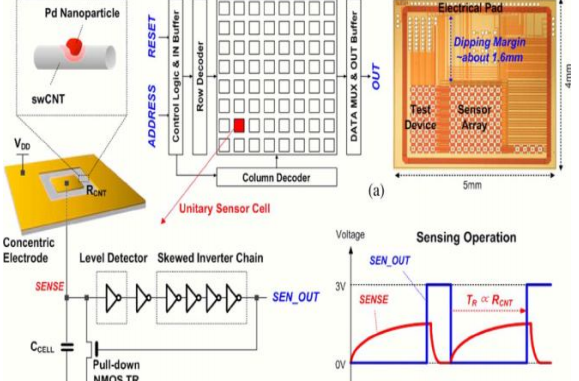
Technical Paper Title: Speech Processing, Speech Synthesis & Speech Recognition
Authors: NIVEDITA PANDEY and PAVAN KUMAR, 5th Semester, EEE
College: AJAY KUMAR GARG ENGINEERING COLLEGE, GHAZIABAD
Abstract: As the technology is moving very fast the next big thing is very small-NANOTECHNOLOGY. Nanotechnology has wide application in all the sector of science and technology. In this paper we have given detail description about carbon nanotube and its properties. It also gives the how these properties can be used to design gas senors. In this paper integration of carbon nanotube (CNT)- based sensor and complementary metal– oxide– semiconductor integrated chip (CMOS IC) to detect hydrogen gas in a single chip is presented. A gas sensor comprised of a gas-responsive multiwall carbon nanotube (MWNT)—silicon dioxide composite layer deposited on a planar inductor- apacitor resonant circuit is presented here for the monitoring of carbon dioxide, oxygen, and ammonia. The absorption of different gases in the MWNT-SiO2 layer changes the permittivity and conductivity of the material and consequently alters the resonant frequency of the sensor.
INTRODUCTION
Carbon nanotubes (CNTs) are tubular structures that are typically of nanometer Diameter and many micromeres in length Because of their tiny size, these nanostructures Exhibit many interesting and often unexpected properties, and these properties have wide applications in making a nanosensor. Carbon nanotubes have found application as field emission devices, electronic switches actuators and random access memory. In addition, there is an increasing demand for the commercial utilization of this material in the industry such as highly sensitive miniaturized biochemical sensors. In this regard, the importance of integration with complementary metal–oxide–semiconductor integrated chip industry becomes greater. One can use a CMOS IC as a sensor platform and build CNT based sensors on top of it. In this paper, we also present the application of multiwall carbon nanotubes (MWNTs) for detection of carbon dioxide, oxygen, and ammonia based upon the measured changes in MWNT permittivity and conductivity with gas exposure.
CARBON NANOTUBE
Carbon nanotubes (CNT) are long, thin cylinders of carbon. They were first observed by Ijima in 1991, during the direct current arching of graphite for preparation of fullerenes. Nanotube structures are made of graphite like carbon (mainly C6 ring fusions) possessing enough C5-ring fusions to allow curvature into. CNTs have remarkable electrical properties.
cylindrical sheets of graphite with an aspect ratio typically greater than 100 and outer diameter measuring tens of nanometer and closed at ends with two semi domes. Essentially, two families of carbon nanotubes exist: (1) Single walled nanotubes (SWNT), made up of only one straight tubular unit. It is a fundamental form of carbon nanotube. The typical structures of SWNTs have been confirmed by scanning tunneling microscopy (STM) and electrical diffraction studies; cylindrical sheets of graphite with an aspect ratio typically greater than 100 and outer diameter measuring tens of nanometer and closed at ends with two semi domes. (2) Multi walled nanotubes (MWNT) made of series of coaxial tubes 0.34 nanometer apart (same distance among the vertical planes of graphite)
APPLICATION OF GAS SENSORS
Gas sensors are used in many industrial, medical, and commercial applications. For example, oxygen sensors are used in the monitoring of combustion engine environment to increase engine performance and reduce emission of green house gases. Ammonia sensors are important for monitoring ambient ammonia concentration since it is related to many environmental issues such as acidification, human health, and climate change through particle formation. In addition to controlling industrial processes and monitoring air quality, CO sensors are also widely used in food and medicine packages as a means of detecting spoilage.
REFFERENCES
1 Development of Carbon Nanotube-Based Sensors—A Review Benjamin Mahar, Cosmin Laslau, Student Member, IEEE, Ronnie Yip, and Yu Sun, Member, IEEE
2. Carbon Nanotube-Based CMOS Gas Sensor IC: Monolithic Integration of Pd Decorated Carbon
3. Nanotube Network on a CMOS Chip and Its Hydrogen Sensing Sung Min Seo, Jun Ho Cheon, Seok Hyang Kim, Tae June
Kang, Jung Woo Ko, In-Young Chung, Yong Hyup Kim, and Young June Park, Senior Member, IEEE
4. A Wireless, Passive Carbon Nanotube- Based Gas Sensor Keat Ghee Ong, Kefeng Zeng, and Craig A. Grimes, Member, IEEE
5. Carbon Nanotubes: Thermal Properties J. Hone Columbia University, New York, New York, U.S.A.
6. Electronic, thermal and mechanical properties of carbon nanotubes By M. S. Dresselhaus1, G. Dresselhaus, J. C. Charlier
and E. Hern´andez 7. Mechanical properties of carbon nanotubes J.-P. Salvetat, J.-M. Bonard, N.H. Thomson, A.J. Kulik, L. Forr´o, W. Benoit, L. Zuppiroli
Please Click here to download the complete Paper: Technical Paper on Carbon Nanotubes And Its Application In Making Gas Sensors – Nivedita Pandey and pavan Kumar
